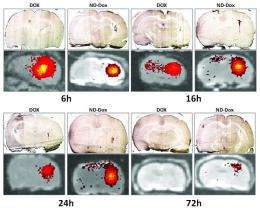New system uses nanodiamonds to deliver chemotherapy drugs directly to brain tumors

(Phys.org) —Researchers at UCLA's Jonsson Comprehensive Cancer Center have developed an innovative drug-delivery system in which tiny particles called nanodiamonds are used to carry chemotherapy drugs directly into brain tumors. The new method was found to result in greater cancer-killing efficiency and fewer harmful side effects than existing treatments.
The research, published in the advance online issue of the peer-reviewed journal Nanomedicine: Nanotechnology, Biology and Medicine, was a collaboration between Dean Ho of the UCLA School of Dentistry and colleagues from the Lurie Children's Hospital of Chicago and Northwestern University's Feinberg School of Medicine. Ho co-directs UCLA Dentistry's Weintraub Center for Reconstructive Biotechnology and is a professor in the division of oral biology and medicine, the division of advanced prosthodontics, and the department of bioengineering.
Glioblastoma is the most common and lethal type of brain tumor. Despite treatment with surgery, radiation and chemotherapy, the median survival time for glioblastoma patients is less than one-and-a-half years. The tumors are notoriously difficult to treat, in part because chemotherapy drugs injected alone often are unable to penetrate the system of protective blood vessels that surround the brain, known as the blood–brain barrier. And those drugs that do cross the barrier do not stay concentrated in the tumor tissue long enough to be effective.
The drug doxorubicin, a common chemotherapy agent, has shown promise in a broad range of cancers, and it has served as model drug for the treatment brain tumors when injected directly into the tumor. Ho's team originally developed a strategy for strongly attaching doxorubicin molecules to nanodiamond surfaces, creating a combined substance called ND–DOX.
Nanodiamonds are carbon-based particles roughly 4 to 5 nanometers in diamter that can carry a broad range of drug compounds. And while tumor-cell proteins are able to eject most anticancer drugs that are injected into the cell before those drugs have time to work, they can't get rid of the nanodiamonds. Thus, drug–nanodiamond combinations remain in the cells much longer without affecting the tissue surrounding the tumor.
Ho and his colleagues hypothesized that glioblastoma might be efficiently treated with a nanodiamond-modified drug by using a direct-injection technique known as convection-enhanced delivery, or CED. They used this method to inject ND–DOX directly into brain tumors in rodent models.
The researchers found that ND–DOX levels in the tumors were retained for a duration far beyond that of doxorubicin alone, showing that doxorubicin was taken into the tumor and remained their longer when attached to nanodiamonds. In addition, ND–DOX was also found to increase apoptosis—programmed cancer-cell death—and to decrease cell viability in glioma (brain cancer) cell lines.
The results also demonstrated for the first time that the ND–DOX delivery limited the amount of doxorubicin that was distributed outside the tumor. This reduced toxic side effects and kept more of the drug in the tumor for longer, increasing the drug's tumor-killing efficiency without affecting the surrounding tissue. Survival time increased significantly in the rats treated with ND–DOX, compared with those given only unmodified doxorubicin.
Nanodiamonds have many facets, almost like the surface of a soccer ball, and can bind to doxorubicin very strongly and quickly, Ho noted. Further research will expand the list of brain-cancer chemotherapy drugs that can be attached to the nanodiamond surfaces to improve treatment and reduce side effects.
For a nanoparticle to have translational significance, it has to have as many benefits engineered into one system as simply as possible.
"Nanomaterials are promising vehicles for treating different types of cancer," Ho said. "We're looking for the drugs and situations where nanotechnology actually helps chemotherapy function better, making it easier on the patient and harder on the cancer."
This study showed that convection-enhanced delivery of ND–DOX offers a powerful treatment delivery system against these very difficult and deadly brain tumors, Ho said.
He noted that this large-scale project has been successful thanks to the multidisciplinary and proactive interactions between his team of bioengineers and their outstanding clinical collaborators from Northwestern University and Lurie Children's Hospital.
More information: www.sciencedirect.com/science/ … ii/S1549963413003547
Provided by University of California, Los Angeles


















